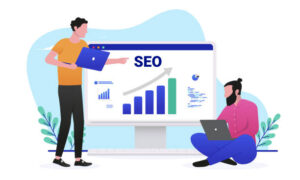
Executing a successful B2B SEO strategy involves mastering technical SEO, creating thoughtful targeted content, and ensuring both your on-page and off-page SEO is on point. We’re going to dive into each of these key elements in detail and discuss what an ideal implementation would look like.
Technical SEO
Technical Search Engine Optimization has to do with your company’s website structure, navigation, page speed, and depth and breadth of content. In essence, the underlying technical details of how your website is built can make or break your SEO strategy before any optimization work begins.
One of the most important aspects of SEO is for your website to be easily accessible by “search engine crawlers” and “search engine spiders” without any technical glitches that can prevent them from rendering and indexing your site.
To validate and improve your technical SEO, it’s recommended to work with knowledgeable developers who can double-check your website’s Javascript, site architecture, URL structure, XML sitemaps, structured data, and 404 pages as well as redirects.
In addition to the purely technical aspects of your website, reviewing your current content for duplicate pages is crucial. Reviewing thin content that’s very short and doesn’t provide value to visitors is important, too.
Before you can begin optimizing your company’s website for B2B, take a step back and review the technical aspects of your site. This is to ensure that your technical SEO is up to par. Technical SEO is the “foundation” of your B2B SEO strategy. It’s in your best interest to get the foundation right before beginning to build anything on top.
Thoughtful Targeted Content
Content is the lifeblood of B2B Search Engine Optimization, as it is what search engines “read”, analyze, and show to searchers. Throughout the SEO process, your business will likely spend a significant chunk of time and money ensuring that your content is targeted, thoughtful, and speaks directly to key decision-makers in your space.
Creating valuable content involves performing keyword research, optimizing your content for keywords and ideal search terms, organizing your content in a logical way, and promoting your content to ensure it gets read.
When doing keyword research, your team should brainstorm what the “ideal decision-maker persona” is searching for your company’s products or services would type into a search engine. The goal is to understand your ideal client better than they understand themselves, and reverse-engineer their thought process in order to come up with the search terms they’re most likely to utilize.
After you’ve determined the keywords and topics you’ll write about, think about how you can organize your content in a way that gets read. This means starting with an engaging hook and creating scannable headings and subheadings. This allows the reader to find sections that interest them most. Don’t forget to include a CTA (call to action) that urges your readers to reach out to your business, book an appointment, or schedule a consultation. Whatever best fits your business model.
Once your content is created: promote, promote, promote! Share your content with other businesses in your space, and try to get more eyeballs on your newly created web pages.
On-Page SEO
Now that you have your technical SEO ironed out and are in the process of creating valuable, targeted content, it’s time to jump into on-page SEO. Just as the name suggests, on-page SEO involves modifying and optimizing elements on your pages directly in order to influence search engine rankings.
Here are several key elements of on-page SEO that you can begin implementing into your web pages:
- Using your target keyword within the first few sentences of your content
- Using primary heading H1 tags for titles, and H2 tags for subheadings. For subheadings within subheadings, use descending H3, H4, etc. tags
- Using outbound external links in your content to reference quality information your reader could find helpful
- Optimizing your web page’s URLs for SEO by making them short and using your keyword within the URL
- Publishing unique content and avoiding duplicate content
- Sprinkling keywords and search terms within your content, but not engaging in “keyword stuffing” where you intentionally pack your content full of keywords. Always write for humans first, search engines second.
In short, on-page search engine optimization involves creating content that search engines can analyze and immediately associate with a topic. You want to create content that gets read and sends positive engagement signals to search engines.
Off-Page SEO
If on-page SEO involves all of the elements on your website’s pages, off-page SEO is also just as it sounds. Off-page SEO works to optimize key search engine ranking factors that don’t reside directly on your company’s website.
Search engines look at your pages in order to analyze search intent and try to make a determination regarding how valuable your content is to readers, but they also look at how other websites are talking about your brand and how many times your company has been mentioned on the web.
Here are the key elements of off-page SEO that can directly influence your search engine rankings:
- Link building, or getting other websites to link to your company’s website. The more times other authoritative websites link to yours, the more likely you are to rank at the top of search engines for your desired terms.
- Brand mentions and reviews online, and how customers are discussing their experiences with your company
- Local search engine optimization, including Google My Business and links from other businesses that operate in your city or region. If your company mostly serves clients in a local region, search engines look at how many times your business is mentioned or linked to in order to establish how trustworthy you are.
- Events and PR. How many times is your business linked to in event postings, and do you get positive PR?
Search engines operate with a simple principle in mind. That principle being if a particular business or brand is getting a significant number of links and mentions from all over the web, they’re probably a reliable company others trust. These “off-page” signals are important in getting your business to the top of the search results.










